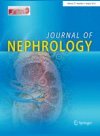Prevalence and clinical association of hyperechoic crystal deposits on ultrasonography in patients with chronic kidney disease: a cross-sectional study from a single center
Abstract
Background
Hyperechoic crystal deposits can be detected in the kidney medulla of patients with gout by ultrasonography examination. Chronic kidney disease (CKD) is usually accompanied with hyperuricemia. Whether hyperechoic crystal deposition could be detected by ultrasonography in CKD patients, and its clinical association are unknown.
Methods
Five hundred and fifteen consecutive CKD patients were included in this observational study. Clinical, biochemical and pathological data were collected and analyzed.
Results
Altogether, 234 (45.4%) patients were found to have hyperuricemia and 25 patients (4.9%) had gout history. Hyperechoic crystal deposits in kidney medulla were found in forty-four (8.5%) patients, on ultrasonography. Compared with patients without hyperechoic crystal deposits, patients with deposits were more likely to be male, younger, with gout history and presenting with higher serum uric acid level, lower estimated glomerular filtration rate, lower urine pH, lower 24 h-urinary citrate and uric acid excretion, and with a higher percentage of ischemic nephropathy (all p < 0.05). On multivariable logistic analysis, the hyperechoic depositions were associated with age [0.969 (0.944, 0.994), p = 0.016], serum uric acid level [1.246 (1.027, 1.511), p = 0.026], Sqrt-transformed 24 h-urine uric acid excretion [0.923 (0.856, 0.996), p = 0.039], and ischemic nephropathy [4.524 (1.437, 14.239), p = 0.01], respectively.
Conclusions
Hyperechoic crystal deposition can be detected in kidney medulla by ultrasonography; in CKD patients their presence was associated with hyperuricemia as well as with ischemic nephropathy.
Graphical abstract




